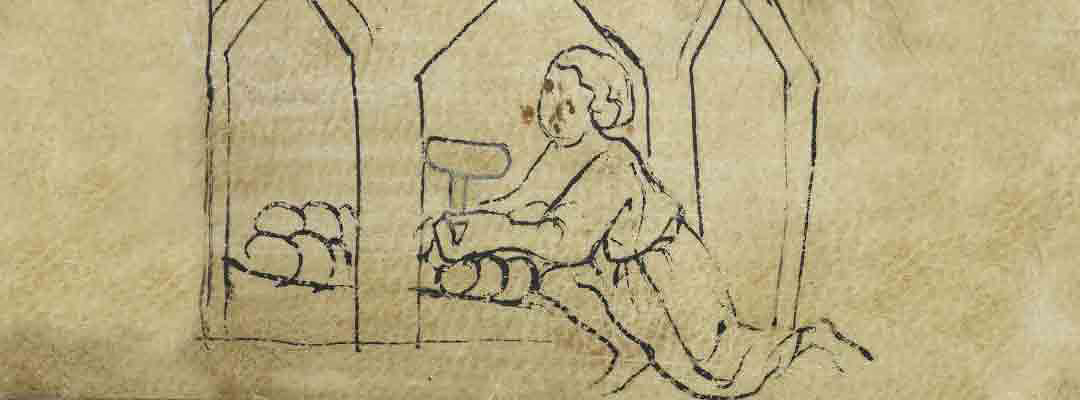Robbery of the King’s Treasure at Westminster Abbey
How a theft from Edward I’s royal treasury at Westminster Abbey did nothing to help strained relations between abbey and royal palace – or the state of the king’s finances.

ROYAL TREASURE
On 6 June 1303, Edward I ordered an investigation into a matter of the gravest seriousness: much of the treasure stored in the supposedly impregnable royal treasury at Westminster Abbey had been stolen.
This treasury was housed either in the Pyx Chamber, which was beside the Chapter House in the Westminster Abbey cloister, or in the Chapter House crypt. The Pyx Chamber, which dates to the 11th century, is named after the wooden boxes, called pyxes, where a sample of the coinage of the realm was held in advance of the ‘Trial of the Pyx’, a public demonstration that the coinage of the day was pure.
Many valuables were held in the treasury – jewellery, crowns, plate, cups of state, ceremonial swords and other precious objects – to be given as presents or used on grand occasions.
SUSPICION
Immediately after the shocking theft of much of this treasure, suspicion fell on the abbot and monks, who consequently were all briefly imprisoned in the Tower of London. But King Edward, perhaps reluctant to humiliate a great royal foundation such as Westminster Abbey, eventually released them.
Further enquiries identified the culprit as one Richard Pudlicote of Oxfordshire, a gentleman who may have had a grudge against the king, having been imprisoned in Flanders a few years earlier as surety for Edward’s growing debts.
THE CONFESSION
According to Pudlicote’s confession, his knowledge of the abbey and the treasury within came from an earlier small-scale theft:
the said Richard had noticed a ladder on a house being roofed near the gate from the palace to the abbey, and he placed this ladder against a window of the chapter house, which opened and shut with a cord: using this cord he opened the window. From there he went to the Refectory door, which he found locked, but opened it with his knife and went inside. He found 6 hanapers [goblets] in a cupboard behind the door, and in another cupboard more than thirty silver dishes and under a bench hanapers [wicker baskets] of drinking cups all gathered up. He took all these away with him and shut the door behind him, but left it unlocked … This is how he knew the layout of the abbey, where the treasury was and how he could get in.
He then worked away patiently for months before this much larger robbery:
Eight days before Christmas he came there to break in with tools acquired for the job, namely two chisels, large and small, a knife and some smaller iron ‘engines’, and he worked at night until a fortnight after Easter, and on the night of Wednesday, the eve of Saint Mark, he got into the treasury, stayed inside through Saint Mark’s day sorting out the things he wanted to carry off, and on the following night he got out, leaving part of the treasure under the bush, to recover it the next night, and the rest he carried away with him, getting away through a gate behind St Margaret’s Church.
SCAPEGOAT
When the loot started showing up in brothels and pawn shops, Pudlicote was arrested with £2,200 worth of stolen property in his possession. He was sentenced to death in November 1305, carted from the Tower of London in a wheelbarrow, and hanged on the Abbot’s Gallows in Tothill Lane.
Pudlicote’s role may have been exaggerated: his confession seems to have been designed to exonerate the monks who must have been complicit in what looked very like an inside job. But clearly an example needed to be made – although a gruesome legend asserting that the skin was flayed from his body and affixed to the treasury door to deter other potential thieves is, it seems, apocryphal.
MONEY TROUBLES
Whoever was to blame, the burglary – and the high-profile trials and sentencing that followed – was a national scandal. It left a lasting mistrust between the king and Westminster Abbey.
And although some of the stolen treasure was eventually recovered, the burglary was also a blow to the king’s finances which he could have done without. When he died in 1307, Edward was probably in debt to the tune of £200,000, then a massive sum. Many petitions in Parliament heard during the last years of his reign testify to resentment at the king’s failure to pay his debts – and much of that money was still owed at the end of his son’s reign 20 years later.
By Jeremy Ashbee
Find out more
-

Visit the Chapter House and Pyx Chamber
Built by the royal masons in 1250, the Chapter House of Westminster Abbey was originally used in the 13th century by Benedictine monks for their daily meetings.
-
English Heritage podcast: a royal raid
Listen to the story of the historic heist dating back more than 700 years – the raid on Edward I’s treasure and its unlikely setting.
-

History of the Chapter House and Pyx Chamber
Read more about the history of these two beautifully preserved medieval spaces, which have been put to both church and secular uses.
-

MORE HISTORIES
Delve into our history pages to discover more about our sites, how they have changed over time, and who made them what they are today.